 Outside the Fresh & Easy Neighborhood Market in Eagle Rock, 60 labor activists and grocery store employees lined up on the sidewalk to rally today against unsafe working conditions and alleged union-breaking tactics at the store.
Outside the Fresh & Easy Neighborhood Market in Eagle Rock, 60 labor activists and grocery store employees lined up on the sidewalk to rally today against unsafe working conditions and alleged union-breaking tactics at the store.
Before the rally, a union field organizer handed out picket signs and arranged participants to make sure the Fresh & Easy sign would in the background for media coverage.
Rabbi Jonathan Klein addressed the crowd by recalling a speech made by Martin Luther King Jr., in which King voiced support for a labor movement in Memphis the day before he was killed on April 4, 1968.
“We’re here to talk about Fresh & Easy and its commitment to the rights of workers to organize, just as Dr. King spoke about sanitation workers just shy of half a century ago,” said Klein, a member of Clergy & Laity United for Economic Justice.
Organizers used the 43rd anniversary of the death of Martin Luther King, Jr. to highlight safety problems at the store and efforts of store workers to unionize.
Activists held up signs to passing cars and handed out stickers for the United Food and Commercial Workers union, which represents employees in the food industry and helped arrange the rally.
The Fresh & Easy grocery store chain has a total of 171 stores with one that opened last year in South Los Angeles. The stores are a subsidiary of British company Tesco.
Fresh & Easy employees came forward to explain why they participated. Mike Acuna pointed to a camera above the doors of the store and said it has been used to monitor for union activity. But he said he was not afraid of being fired.
“We workers want to be out there and express our right to unionize because we feel that’s the only way that we can create change in the company,” said Acuna. “I know I have a right to stand here.”
Acuna, a 34-year-old Highland Park resident, said he was injured on the job when he pulled his back while unloading cases of groceries. He claimed the store last year began requiring employees to unload 65 boxes per hour, a marked increase.
On March 26, 2010, Acuna said 21 employees signed a petition for better health and safety conditions and presented it to the management. Employees claim the company retaliated when the employees’ hours were reduced and four employees were terminated.
A new manager was transferred to the store along with six other employees. Acuna said injuries increased, with 17 occurring since the petition was signed and four workers advised to get back surgery. The employees claimed the company would not meet to discuss health and safety conditions.
Fresh & Easy spokesman Brendan Wonnacott said he would not comment on specific claims of injuries and retaliation.
“Punishing union supporters is against the law,” said Wonnacott. “Obviously that would not be the case here.”
Wonnacott said the UFCW and employees who are trying to organize the Fresh & Easy staff did not follow the rules for forming a union set by the National Labor Relations Board. He referred specifically to the rule which requires employees to vote on unionization by a secret ballot which does not show how a person voted.
“All along, since we opened our first door, we have maintained that the choice to join the union is the choice that can only be made by employees,” said Wonnacott. “It’s their democratic right to do so.”
The spokesman added that the company has an open door policy which allows all employees to discuss concerns with management freely.
“From what we hear in stores, all 171 that we have opened, people are very happy with the setup as it is,” Wonnacott said. “If there are concerns people are more than welcome to come and address them.”
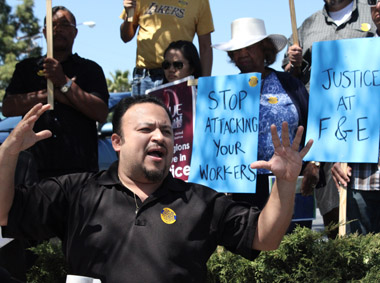 “To me that open door policy is not really in force,” responded Acuna. “I feel like it’s not open to freely say what you want. I feel like whatever you say can be used against you.”
“To me that open door policy is not really in force,” responded Acuna. “I feel like it’s not open to freely say what you want. I feel like whatever you say can be used against you.”
Acuna said employees in the Eagle Rock store chose not to use a secret ballot because they felt the company was maneuvering to make the vote fail. He claimed six employees were brought in from other stores to throw off the pro-union majority.
Carlos Juarez, a 37-year-old Fresh & Easy employee, who also was injured on the job, held up a flier created and distributed by the store to customers. The flyer stated that protesters at a recent rally were not employees of the store.
“And that’s a lie,” said Juarez. “We’re here. This is a decision that we made.”
The two employees said that they just want the store to be a better place to work, but added the pay could also be better. Acuna and Juarez said they make the highest salary for staff members, pulling in $10.90 per hour.
Acuna said the company has been busy opening new stores in Northern California.
“If they have money to do that, then they have money to help their employees,” said Acuna.
Spokesman Brendan Wonnacott said that the company opened 16 stores in 2011. Figures provided by Tesco show the company’s sales in the U.S. were up 38 percent in the third quarter of last year.
As the rally wrapped up, the crowd chanted “Si se puede,” Spanish for “Yes, it can be done.”
Afterward Acuna said his plan is to present to the corporate office a strategy to improve health and safety conditions at the stores.
“We want this company to succeed,” Acuna said. “And the only way they’re going to be able to make that happen is to make their employees happy and theyíre not making that.”









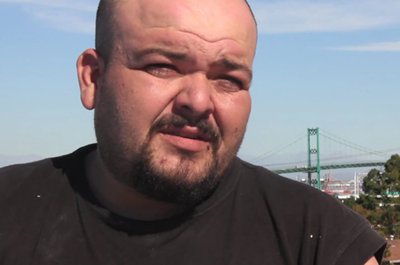 Carlos Garcia of West Covina became a citizen in 2008 right before the presidential elections. He believes voting is the most important privilege new citizens receive.
Carlos Garcia of West Covina became a citizen in 2008 right before the presidential elections. He believes voting is the most important privilege new citizens receive. The City of Los Angeles is moving forward on a $20 million South Los Angeles development project but not after a messy, 20-year struggle that has turned a spotlight on a redevelopment process that in the past has resulted in empty fields and broken promises.
The City of Los Angeles is moving forward on a $20 million South Los Angeles development project but not after a messy, 20-year struggle that has turned a spotlight on a redevelopment process that in the past has resulted in empty fields and broken promises. “It’s fashionable now to look at this community as a new frontier in a place of possibility,” said Mark Williams, Tate’s son and Concerned Citizens’ director of youth programs. “It wasn’t always that way.”
“It’s fashionable now to look at this community as a new frontier in a place of possibility,” said Mark Williams, Tate’s son and Concerned Citizens’ director of youth programs. “It wasn’t always that way.” “Juanita Tate is not a major player by no stretch of the imagination until Jan Perry comes to office. But by her coming to office it enables her to become an absolute major player,” added Deacon. “We don’t see that until we see her relationship with developers.”
“Juanita Tate is not a major player by no stretch of the imagination until Jan Perry comes to office. But by her coming to office it enables her to become an absolute major player,” added Deacon. “We don’t see that until we see her relationship with developers.”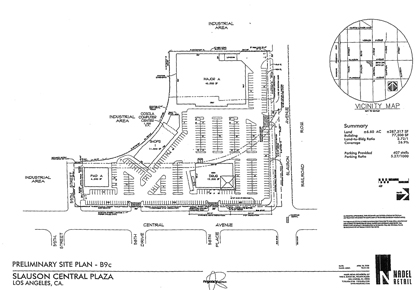
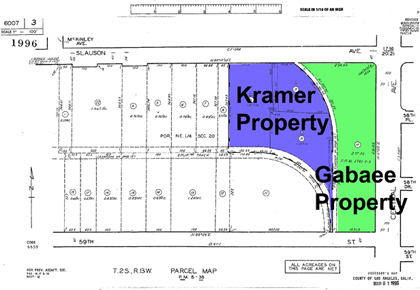
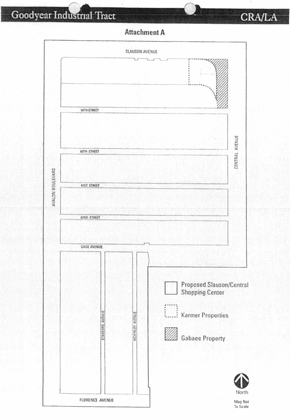
 On the Sunday after Thanksgiving, the temperatures downtown dipped into low 40′s. In Pershing Square, Angelinos glided around a skating rink which is ringed by trees decorated with Christmas lights. Nearby, a small line of L.A.’s down-and-out population formed up for a free dinner. The smell of greens and beans was in the air along with holiday music as a band of volunteers dished out the food. The volunteers brought with them large vats of food, along with hot sauce, plates and water, but one thing they didn’t bring with them is bombs.
On the Sunday after Thanksgiving, the temperatures downtown dipped into low 40′s. In Pershing Square, Angelinos glided around a skating rink which is ringed by trees decorated with Christmas lights. Nearby, a small line of L.A.’s down-and-out population formed up for a free dinner. The smell of greens and beans was in the air along with holiday music as a band of volunteers dished out the food. The volunteers brought with them large vats of food, along with hot sauce, plates and water, but one thing they didn’t bring with them is bombs. Some chapters actually do end up serving meat which is not encouraged because of health and food safety reasons. Aaron Linas, another volunteer, added that some chapters are more overtly political than others. He said some chapters will bring literature when they hand out food, but the L.A. chapter is not as political as those ones.
Some chapters actually do end up serving meat which is not encouraged because of health and food safety reasons. Aaron Linas, another volunteer, added that some chapters are more overtly political than others. He said some chapters will bring literature when they hand out food, but the L.A. chapter is not as political as those ones.




